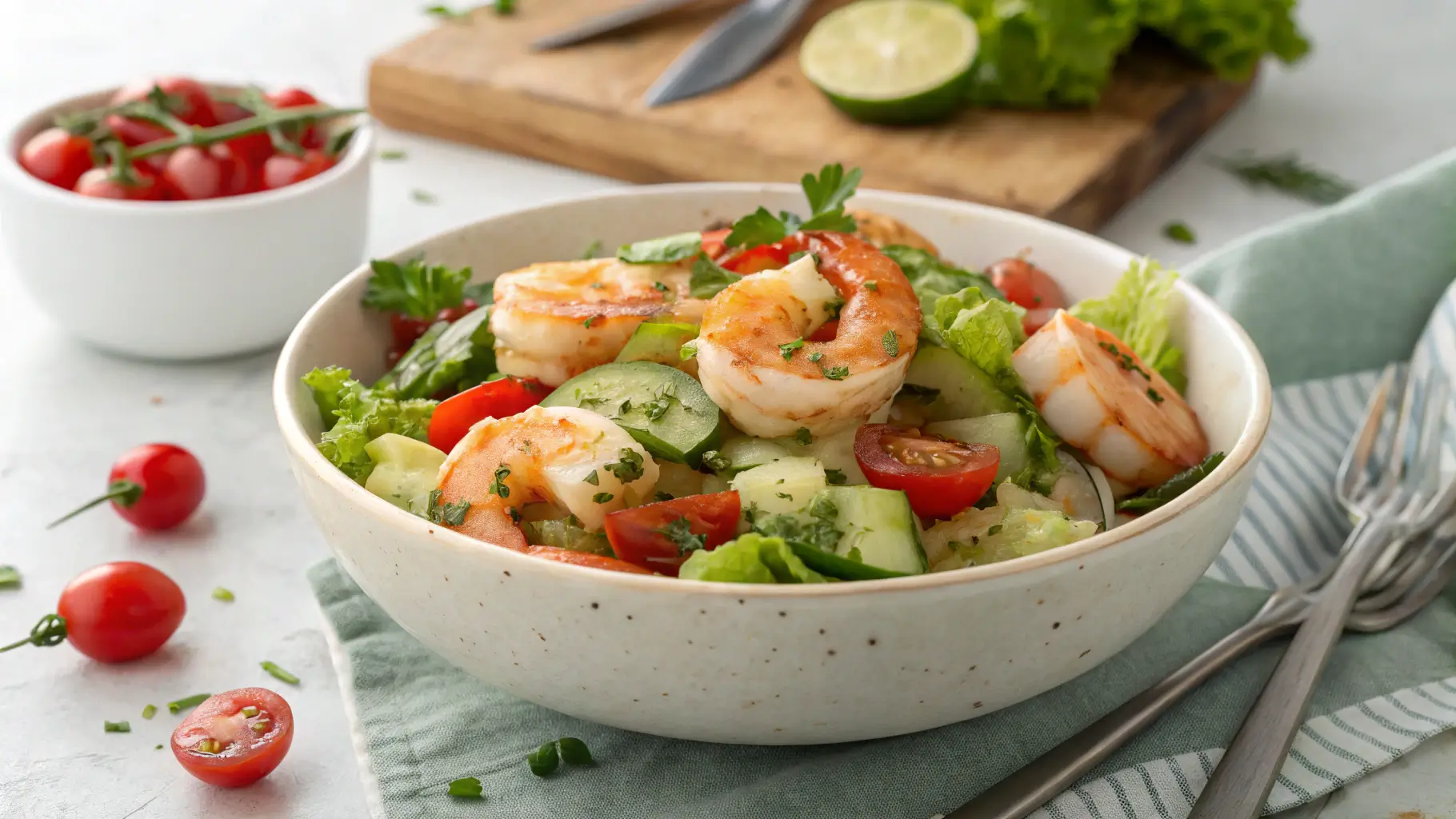Looking for the best shrimp salad recipe? Create a restaurant-worthy version in just 30 minutes! This creamy, tangy dish combines perfectly cooked shrimp with crunchy vegetables that you can serve multiple ways. Load it onto crispy toast, spoon it into fresh lettuce cups, or build a satisfying sandwich. You’ll need 2 pounds of jumbo shrimp and simple ingredients like cucumber, red onion, and dill. The result is a protein-rich meal that packs 24.3 grams of protein in each serving. Our chef-tested techniques will help you create the best shrimp salad that stays fresh up to 4 days in your refrigerator. Let’s take a closer look at the secrets to become skilled at selecting the right shrimp and mixing the perfect dressing ratio. This detailed guide will help you create a shrimp salad that matches your favorite seafood restaurant’s version.
Selecting the Perfect Shrimp for Your Salad
Your shrimp salad’s success starts way before you turn on the stove. The shrimp you pick makes a huge difference in your dish’s flavor, texture, and quality.
Fresh vs. Frozen: What Chefs Actually Prefer
Most professional chefs would tell you something surprising – they prefer frozen shrimp over “fresh” for shrimp salad. Living near the coast with access to fresh-caught shrimp is rare. Those “fresh” shrimp you see at seafood counters were frozen earlier and thawed by the fishmonger. Shrimp muscle tissue starts breaking down just 24 hours after thawing, which leads to mushy texture and less flavor.
You’ll get better results with individually quick-frozen (IQF) shrimp that you defrost right before cooking. Boats flash-freeze these shrimp immediately after catching them, which keeps their natural sweetness and texture intact. On top of that, it helps that IQF shrimp don’t stick together in clumps, so you can grab exactly what you need.
Size Matters: Choosing the Right Shrimp Size
Shrimp sizes work by count per pound – bigger shrimp mean lower numbers. A “26/30” label tells you there are 26-30 shrimp in each pound. While “jumbo” isn’t a standard term, here’s what these labels usually mean:
- Small: 51+ per pound
- Medium: 36-50 per pound
- Large: 26-40 per pound
- Jumbo: 16-25 per pound
Medium to large shrimp (26-40 count) work great in shrimp salad. These sizes pack great flavor and stay tender in cold dishes. Smaller shrimp (31-35 count) fit perfectly in salads because they cook fast and spread evenly throughout the dish.
Wild-Caught vs. Farm-Raised: Flavor Differences
A shrimp’s source changes its taste by a lot. Wild-caught shrimp get their distinct flavor from eating plankton and tiny sea creatures, which gives them a stronger, sweeter taste and firmer texture. People think they’re better quality, but they cost more.
Farm-raised shrimp eat fishmeal and other feeds, which affects their taste and texture differently. They’re cheaper and you can find them year-round, but they don’t taste as strong. Seafood lovers say wild-caught shrimp – especially pink and white varieties – have that sweet taste that makes a classic shrimp salad special.
Wild-caught Gulf or Pacific shrimp are your best bet for a great salad – their natural flavor really stands out in the final dish.
Chef’s Secret Techniques for Perfectly Cooked Shrimp
Becoming skilled at cooking techniques makes a huge difference in preparing perfect shrimp. Your shrimp salad can go from basic to amazing with three chef-proven methods that separate tender, succulent shellfish from rubbery, overcooked ones.
The Poaching Method for Tender, Juicy Shrimp
Chefs love poaching shrimp for salads because it keeps them moist and boosts their natural sweetness. Here’s a gentle approach that works better than direct boiling:
- Create a flavorful poaching liquid with water, salt, lemon, bay leaves, and aromatics like garlic
- Bring the liquid to a boil, then turn off the heat
- Add your cleaned shrimp to the hot (not boiling) water
- Cover and let them steep for 3-5 minutes until pink and opaque
This gentle method prevents the toughness you get from high-heat cooking. The pot’s removal from heat before adding shrimp creates the ideal temperature range (around 170°F) that stops overcooking.
Ice Bath Technique: Why It’s Non-Negotiable
An ice bath isn’t optional – it’s crucial for perfect shrimp salad. Once your shrimp finish poaching:
- Immediately transfer them to a bowl filled with ice and water
- Let them chill for 3-5 minutes
- Drain them well before using in your salad
This quick cooling stops the cooking process right away, which prevents any carryover heat from making your shrimp rubbery. Many chefs put shrimp in a resealable plastic bag before the ice bath to keep their flavor intact.
How to Tell When Shrimp is Perfectly Done
The shrimp’s shape tells you everything about doneness. Watch how they curl as they cook:
- C-shape: Perfect shrimp form a loose “C” shape
- O-shape: Overcooked shrimp curl tightly into an “O”
Well-cooked shrimp show a pearly pink color with bright red tails. Their flesh should feel firm yet tender – never mushy or rubbery. This simple visual guide helps you get consistently perfect results for your best shrimp salad recipe.
Creating the Ultimate Shrimp Salad Dressing
A great shrimp salad dressing is the key flavor bridge between tender seafood and fresh vegetables. The right dressing will lift your dish from simple to restaurant-quality.
The Perfect Mayo-to-Acid Ratio
The best shrimp salad dressing starts with the right balance of creaminess and acidity. Professional chefs usually follow a 3:1 ratio of oil to acid when making emulsions, which works perfectly for mayonnaise-based dressings. Mix ½ cup mayonnaise with about 2-3 tablespoons of fresh lemon juice or vinegar to make a classic shrimp salad recipe. This mix will give you enough creaminess without overwhelming the shrimp’s delicate flavor.
You can make a lighter version by replacing half the mayonnaise with Greek yogurt or sour cream. This will add extra tanginess and protein while cutting down on calories. Many chefs suggest a 50/50 mayo-to-sour cream ratio to create a perfectly balanced creamy base.
Fresh Herbs That Boost Shrimp Flavor
Fresh herbs can revolutionize a simple shrimp salad. Dill stands out as the classic choice—its bright, slightly anise-like flavor naturally complements seafood. Most recipes need 2 tablespoons of finely chopped fresh dill. You can use dried dill at a 1:3 ratio (2 teaspoons dried for 2 tablespoons fresh).
These herbs also pair beautifully with shrimp:
- Chives for mild onion notes
- Tarragon for sophisticated licorice undertones
- Parsley for clean freshness
- Cilantro for citrusy brightness
Balancing Flavors Like a Professional Chef
Good balance needs more than just mayo and herbs. Dijon mustard (about 1 tablespoon per cup of mayo) works two ways—it adds tangy depth and acts as an emulsifier that keeps your dressing stable. Professional cooks also add minced garlic or grated horseradish to create extra dimension.
The final result should be perfect. A pinch of salt brings out flavors, fresh black pepper adds complexity, and a dash of hot sauce or cayenne creates depth without too much heat. It’s worth mentioning that a well-made dressing should enhance—not hide—your perfectly cooked shrimp.
Texture and Flavor Combinations in Classic Shrimp Salad
A truly exceptional shrimp salad stands out because of its contrasting textures and complementary flavors. Shrimp salad gets its memorable quality from the careful balance between crisp elements and tender shellfish, unlike many other seafood dishes.
Essential Crunch Elements
Professional chefs know that great shrimp salad recipes need specific crunchy components. Crisp celery ribs show up in almost every recipe and provide the perfect texture contrast against tender shrimp. The inner, tender ribs work better than tougher outer stalks. Red onion brings both sharpness and crunch to the mix, though some chefs prefer green onions for a milder taste. Red bell peppers add sweetness and a definitive crunch while making the dish more colorful.
Cucumber proves to be the perfect refreshing counterpoint to rich, creamy dressing elements, according to many chefs. Its high water content (96%) helps hydrate the dish and adds essential minerals like potassium and magnesium. The addition of cabbage creates interesting textures in coleslaw-inspired versions, which work well with sweet bell peppers and green onions.
Unexpected Ingredients That Professional Chefs Add
Expert chefs go beyond simple crunch elements to improve homemade recipes to restaurant quality. Small, non-pareil capers create briny bursts that balance the sweetness of well-cooked shrimp. You should use them sparingly since larger capers can dominate individual bites.
Pickled okra might seem unusual, but one chef calls it “the real knockout flavor punch.” These should stay whole because cutting releases seeds that can overpower the flesh.
Chefs often add these sweet elements:
- Grapefruit segments
- Pineapple pieces for tropical notes
- Fresh grapes that add juicy pops of sweetness
- Apple pieces with crisp sweetness
Toasted nuts, especially slivered almonds, add sophisticated texture that takes ordinary recipes to the next level. Even untoasted nuts bring welcome complexity to classic shrimp salad recipes, though toasting improves their flavor.
Conclusion
Making restaurant-quality shrimp salad just needs you to focus on a few key elements. High-quality frozen shrimp, especially wild-caught varieties, are the foundations of exceptional flavor. You’ll get perfectly tender and succulent shrimp when you master gentle poaching techniques and follow up with an ice bath.
Your results will rival professional kitchens if you pay attention to dressing ratios, fresh herb combinations, and strategic texture pairings. The right crunchy elements like celery and red onion, along with unexpected ingredients such as pickled okra, can change an ordinary dish into something memorable.
Note that great shrimp salad depends on both your technique and ingredient quality. These chef-tested methods and insider tips will help you create impressive dishes that match upscale restaurant offerings. As you practice these techniques and try different variations, this shrimp salad will become a standout in your cooking arsenal.
FAQs
What are the key ingredients for a delicious shrimp salad?
A classic shrimp salad typically includes cooked shrimp, cucumber, red onion, fresh dill, mayonnaise, Dijon mustard, lemon juice, salt, and pepper. For added flavor, you can incorporate ingredients like garlic, fresh chives, and Greek yogurt.
How can I enhance the flavor of shrimp in my salad?
To bring out the best flavor in shrimp, use citrus fruits like lemon or lime, garlic, and herbs. Simple seasonings such as salt, pepper, and paprika also complement shrimp well. These flavors balance each other and enhance the natural sweetness of the shrimp.
What’s the ideal dressing for a shrimp salad?
A popular dressing for shrimp salad is a combination of mayonnaise and lemon juice, typically in a 3:1 ratio. For a lighter version, you can substitute half the mayonnaise with Greek yogurt or sour cream. Adding Dijon mustard and fresh herbs like dill can further elevate the flavor profile.
How do I ensure my shrimp are perfectly cooked for the salad?
For tender, juicy shrimp, use the poaching method. Create a flavorful liquid with water, salt, lemon, and aromatics. Bring it to a boil, turn off the heat, add the shrimp, and let them steep for 3-5 minutes until pink and opaque. Immediately transfer them to an ice bath to stop the cooking process.
What unexpected ingredients can elevate my shrimp salad?
Professional chefs often add surprising elements to enhance shrimp salad. Consider incorporating small capers for briny bursts, pickled okra for a flavor punch, or fruit elements like grapefruit segments or pineapple pieces for contrasting sweetness. Toasted nuts, such as slivered almonds, can also add sophisticated texture variation.


